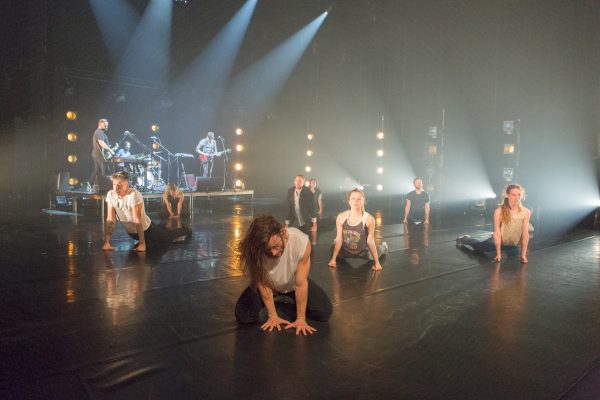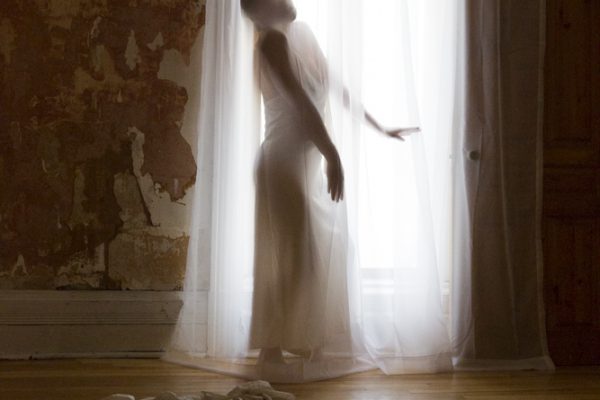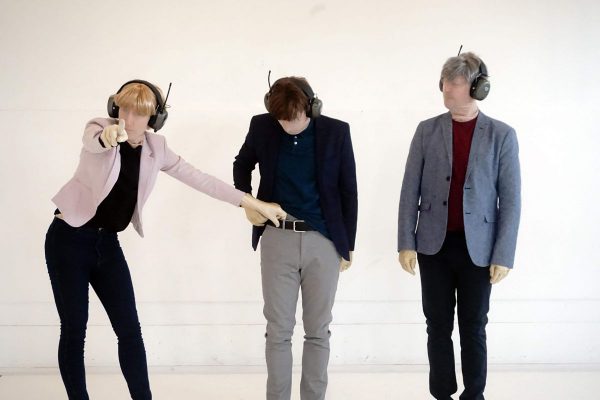George Stamos is the kind of choreographer that can't make tidy dances, but that's not to say he doesn't use his material judiciously. In "Schatje" (the affectionate Dutch word "honey", which, according to Stamos, is used by gays, prostitutes and drag queens), he's feeding on club and strip joint behaviour in a theatrical setting, and everything and everyone is open to scrutiny – the manipulator and the manipulated, the subject/object and the viewer/viewed. His landscapes are slices of reality, but reality just outside the realm of the norm.
Over the years, his work has investigated the world of the sex worker, castration, erotic dance – usually forbidden subjects in the theatrical dance world. Stamos is inspired to delve into a closer representation of what a certain slice of life is like. Here, Stamos is pushing an exploration of what we think or what we think we know. Life's complexities interest him. In "Schatje", he sets up (and quite successfully so) a series of complex connections between, say, a stripper, a wrestler, a prostitute and an artist. Stamos is evolving a recognizable style and format for his performances that seems to mix the autobiographical with social and political ideas, subverting the club-world format with intelligent wit, edgy images and a zingy style that is conceptually devoid of pretension. There's a restless energy and a rawness to what's happening in the room. The performers in the vignettes have personalities; they are not hiding the fact that they're performing (and being very physical) – being exhibitionists for the audience.
The show combines sex and violence and picks apart themes: there's posturing, pill popping, simulated copulation, body bags, body combat, hand puppets, unison dancing and well-honed improvisation. The show starts outside the hall upon arrival. The audience members remove their street shoes and slip on soft blue fabric medical slippers, in preparation to circulate through the performance space before settling into their seats. Two video monitors near the entry to the black box theatre spotlight Lucite-heeled stripper shoes. The audience enters through the side door of the stage, with the cast already in place on the performance floor: Stamos is teetering in similar shoes, in blue tighty briefs and tank top; a woman is strapped into a body-suit-like garment; a tall man with long blond hair is prone over a double bass, wearing thigh-high white leather boots, his tresses blowing in the breeze of a fan. Stamos' face is projected close-up on a large screen dividing the room. In the video, the camera captures his slighest facial gesture. Ultimately, he opens his mouth and we see one of his front teeth is missing. The openness in the video projection is then symbolically transferred to what is being danced in live performance.
"Schatje" is a multi-dimensional collaborative effort, during the creative development drawing on the participation of his candid and likeable, versatile cast (dancers Tonja Livingstone, Luciane Pinto and Stamos himself, DJ/composer Owen Chapman and double bassist Mark Peetsma, with videos by Jonathan Inksetter), giving it a multi-referential intensity. One of the greatest bonuses of "Schatje" is that you really can sense the presence of the artists. Livingstone is fearless as the woman being hoisted and balanced in the body-suit – her sense of risk astonishes and her tensor-bending flexibility keep your eyes glued to every move she makes. In the context of the music, Chapman, who's a newcomer to the theatre setting, concentrates like mad generating the soundscape live on-stage, joyously teasing sounds of all sorts from his vinyls and other sound sources.
Based in Montréal for the last five years, Stamos grew up in Dartmouth, Nova Scotia, and his personal history reads like something ripped from a tabloid: petty thievery as a teen (which led to community service work in a dance studio), life on the streets, time spent gravitating around drag queens and prostitutes in the red light district in Amsterdam, New York, Toronto and London. Plus he's rubbed shoulders with queer icon Quentin Crisp, earned cash gogo-dancing and worked in residence with the radical theatre group Mabou Mines. The dancer-choreographer's formal dance training kept him moving too, from the School of Toronto Dance Theatre, to the School for New Dance Development in Amsterdam, to Erick Hawkins' studio in New York.
In this creation, Stamos uses the basic grammar that he has gleaned from working with performer-choreographer Benoît Lachambre. "Schatje" sets out its themes diffusely and introduces layers of political content. Like Lachambre, Stamos delves into the particular politics of performance that flaunts black humour and perverts reason. For the more sheltered spectator, Stamos offers a sufficient glimpse of the smarm of the tenderloin to keep people watching. He doesn't do didactic work and, while the overall evocation is kitsch and synthetic, Stamos' well-worn sense of club life provides the steady control for his theatrical impulses. The concept he's chosen – a bazaar of impressions with deliberate intentions – illustrates a conversation between violence and what he's calling grace, which is beauty, the recovery from violence and abrasiveness. With Stamos, urgency and bonding are leavened with humor, a sense of proportion, sincerity. Over the period of time he's worked on "Schatje", it has moved from a seemingly random splatter of ideas, nonsensically arranged, to something which still is fragmented by what seem like fragments of an entity.
Tagged: Contemporary, Interdisciplinary, Performance, Montréal , QC




